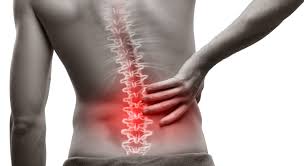There’s a pretty good chance you or someone you know has complained about lower back pain. As a matter of fact, over 80% of Americans suffer from lower back pain, so it’s all too common. But the question lingers: what do we do about it? In order to handle lower back pain, we need to assess what is causing the pain. Sometimes a proper physical activity program may be enough to relieve the pain, but sometimes there is a need for medical intervention. For purposes of this blog, we’ll discuss the physical interventions. Although there is a time and place for surgery and other interventions, many times proper exercise can alleviate the pain.
Let’s find the part of the back that hurts. We’ll start with the entire span of the lower back, from the top of the hip crossing over the spine and going side to side. In this case, there is probably a compression in the lower vertebrae. Typically we hear of problems in the L4, L5, and S1 regions (This refers to the lowest parts of the vertebrae: the 4th and 5th vertebrae of the lumbar spine and the sacrum). The compression will usually be caused from the pelvis being tilted forward. You see, the spine and all the vertebrae connect to the pelvis. We call that the axial skeleton, and it’s all connected. So wherever the pelvis goes, the spine follows. Because we all spend so much time sitting, this has a tendency to tighten up the hip flexors in the front of the pelvis. This in turn will pull the pelvis forward, and will pull the lumbar spine forward. To give a better tangible example, hold a rope or string and have someone else hold it on the other side. When you pull the rope, watch the other person come forward. The rope represents the muscle being tightened, and the people represent the bones forming the joint, in this case the vertebrae. Consequently, as this happens, the muscles in the lower back also tighten up. If you read my previous post about the neck, these muscles have a similar bowing effect that will crunch the vertebrae so the back side of them start to crush, and the front side of them open more. This often leads to disc herniations, bulging, nerve impingements, sciatica and lower back pain. Untreated, these kinds of pain can lead to improper walking gait, hip dysfunction, pelvic shifts, and further medical intervention, so let’s stay away from the laminectomy.
Fixing this through exercise is relatively easy. This is what we call “lower cross syndrome,” because the resolution is a big X. First thing we need to do is stretch those tight hip flexor muscles. One of my personal favorites is doing a warrior pose in yoga. It really places a good stretch on the front of the hip and thigh. Then we need to stretch the lower back muscles. Draping yourself forward is a good way to do this, but relax the knees. This is not supposed to be a hamstring or leg stretch. Let the knees bend and relax at the lower back. Another great yoga stretch for this is doing a sun salutation. Now we’ve got one line of the X, and we have to do the second.
Stretching is one part of the fix, and flexibility only accounts for 1 out of 5 of the components of fitness. Next we have to strengthen the other two parts. This is where core strength and exercise comes into play. I don’t mean just sit ups, but tighten those inner core muscles. Think of a dad at the beach sucking in his dad-bod gut to tone up. Give a hearty cough and feel the stomach contract inwards. Pretend you are vomiting, and feel the stomach again suck inward. These are great ways to activate the inner core muscles, which actually wrap around the spine to create this stability to prevent it from going forward again. And to compliment that, we cannot forget the hips, or the butt (glutes). Squeezing the glute muscles helps stabilize the hips, thus preventing them from tilting forward due to improper posture and chronic sitting. Therefore, we have now completed the X. Stretch the front hip flexors and low back muscles, and then strengthen the inner core and glute muscles, and overtime the chronic low back pain will resolve.
Now, there are other variations of lower back pain. Sometimes we feel pain on one side of the spine. Sometimes the pain radiates into the butt or hip joint. Sometimes the sciatica runs down the leg. These orthopedic impairments deserve closer observation as many times they are the result of some sort of spinal deviation one way or another. Many times proper manual manipulation by a therapist, chiropractor or even a fitness individual trained in myofascial release can help these, and sometimes it may involve a medical intervention. But don’t place too much hope on a shot as it does not fix the root cause of the pain, only band-aids the pain. Be honest and thorough with your health and fitness professional about what you are feeling so that a proper program can be put into place to support your core and back pain.
This is a good start to go, and will only get better when you start to implement these types of corrective exercise into your program. Good luck and feel free to contact me with any questions, comments or concerns regarding your back or overall health questions!


